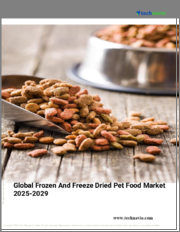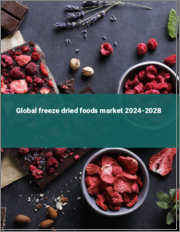
|
시장보고서
상품코드
1677981
동결 건조 식품 시장 규모, 점유율, 성장 분석 : 제품 유형별, 성질별, 형태별, 최종 용도별, 유통 채널별, 지역별 - 산업 예측(2025-2032년)Freeze-Dried Food Market Size, Share, and Growth Analysis, By Product Type (Fruits, Vegetables), By Nature (Organic, Conventional), By Form, By End Use, By Distribution Channel, By Region - Industry Forecast 2025-2032 |
||||||
세계의 동결 건조 식품 시장 규모는 2023년에 425억 달러로 평가되며, 예측 기간(2025-2032년)에 CAGR 8.3%로 성장하며, 2024년 460억 3,000만 달러에서 2032년에는 871억 1,000만 달러로 성장할 전망입니다.
동결건조 식품 시장은 캠핑이나 하이킹과 같은 아웃도어 활동에 대한 관심 증가와 더불어 군용 및 비상시 사용 증가로 인해 성장세를 보이고 있습니다. 소비자들은 편리하고 건강한 식품을 찾는 경향이 높아지면서 동결건조 식품에 대한 수요를 주도하고 있습니다. 주목할 만한 동향은 건강한 간식에 대한 욕구가 증가하고 있으며, 전 세계 소비자의 약 80%가 신체적, 정신적 건강을 증진시키는 간식을 적극적으로 찾고 있다는 점입니다. 이러한 추세는 제품의 기술 혁신을 촉진할 뿐만 아니라, 영양가 높은 비상식량 보존 솔루션으로의 흐름과 맞물려 시장 성장을 더욱 촉진하고 있습니다. 소비자들이 맛과 영양소를 우선시하는 가운데, 동결건조 식품 분야는 향후 수년간 크게 성장할 것으로 예상됩니다.
목차
서론
- 조사의 목적
- 조사 범위
- 정의
조사 방법
- 정보 조달
- 2차와 1차 데이터 방법
- 시장 규모 예측
- 시장의 전제조건과 제한
개요
- 세계 시장 전망
- 공급과 수요 동향 분석
- 부문별 기회 분석
시장 역학과 전망
- 시장 개요
- 시장 규모
- 시장 역학
- 촉진요인과 기회
- 억제요인과 과제
- Porter의 산업 분석
주요 시장 인사이트
- 주요 성공 요인
- 경쟁의 정도
- 주요 투자 기회
- 시장 에코시스템
- 시장의 매력 지수(2024년)
- PESTEL 분석
- 거시경제 지표
- 밸류체인 분석
- 가격 분석
동결 건조 식품 시장 규모 : 제품 유형별
- 시장 개요
- 과일
- 딸기
- 라즈베리
- 파인애플
- 사과
- 망고
- 기타 과일
- 채소
- 당근
- 감자
- 옥수수
- 완두콩
- 버섯
- 기타 채소
- 동결 건조 유제품
- 동결 건조육과 씨푸드
- 동결 건조 애완동물 사료
- 조리 밀(Prepared Meal)
동결 건조 식품 시장 규모 : 성질별
- 시장 개요
- 오가닉
- 기존형
동결 건조 식품 시장 규모 : 형태별
- 시장 개요
- 분말
- 과립
- 다이스
동결 건조 식품 시장 규모 : 최종 용도별
- 시장 개요
- 식품 및 음료 제품
- 아침식사용 시리얼
- 유제품
- 베이커리 & 제과
- 영양 바와 보충제
- 분말 음료
- 스낵
- 소매(가정)
동결 건조 식품 시장 규모 : 유통 채널별
- 시장 개요
- 기업용
- 소비자용
- 하이퍼마켓/슈퍼마켓
- 편의점
- 전문점
- 식품 및 음료 전문점
- 독립계 소규모 식료품점
- 온라인 소매
동결 건조 식품 시장 규모
- 북미
- 미국
- 캐나다
- 유럽
- 독일
- 스페인
- 프랑스
- 영국
- 이탈리아
- 기타 유럽 지역
- 아시아태평양
- 중국
- 인도
- 일본
- 한국
- 기타 아시아태평양
- 라틴아메리카
- 브라질
- 기타 라틴아메리카 지역
- 중동 및 아프리카
- GCC 국가
- 남아프리카공화국
- 기타 중동 및 아프리카
경쟁 정보
- 상위 5사의 비교
- 주요 기업의 시장 포지셔닝(2024년)
- 주요 시장 기업이 채택한 전략
- 최근 시장 동향
- 기업의 시장 점유율 분석(2024년)
- 주요 기업의 기업 개요
- 기업의 상세
- 제품 포트폴리오 분석
- 기업의 부문별 점유율 분석
- 매출의 전년대비 비교(2022-2024년)
주요 기업 개요
- Nestle S.A.(Switzerland)
- Unilever(UK)
- Kraft Heinz Company(USA)
- Conagra Brands, Inc.(USA)
- Associated British Foods plc(UK)
- General Mills, Inc.(USA)
- European Freeze Dry(Denmark)
- Harmony House Foods, Inc.(USA)
- Mountain House(USA)
- Key Developments
- Katadyn Group(Switzerland)
- Mercer Foods(USA)
- Wise Company(USA)
- Lyo Food Sp. z o.o.(Poland)
- Paradise Fruits Solutions GmbH & Co. KG(Germany)
- Sleaford Quality Foods Ltd.(UK)
- Freeze-Dry Foods GmbH(Germany)
- Oregon Freeze Dry, Inc.(USA)
- Cerebos Pacific Limited(Singapore)
- Asahi Group Holdings, Ltd.(Japan)
결론과 제안
KSA 25.04.24Global Freeze-Dried Food Market size was valued at USD 42.5 billion in 2023 and is poised to grow from USD 46.03 billion in 2024 to USD 87.11 billion by 2032, growing at a CAGR of 8.3% during the forecast period (2025-2032).
The market for freeze-dried foods is gaining momentum due to the rising interest in outdoor activities like camping and hiking, coupled with increased usage in military and emergency situations. Consumers are increasingly seeking convenient and healthy meal options, driving demand for freeze-dried products. A notable trend is the growing appetite for healthy snacks, with nearly 80% of global consumers actively seeking snacks that enhance physical and mental well-being. This shift not only supports product innovation but also aligns with the ongoing trend towards nutritious emergency food storage solutions, further propelling market growth. As consumers prioritize flavor and nutrients, the freeze-dried food sector is poised for significant expansion in the coming years.
Top-down and bottom-up approaches were used to estimate and validate the size of the Global Freeze-Dried Food market and to estimate the size of various other dependent submarkets. The research methodology used to estimate the market size includes the following details: The key players in the market were identified through secondary research, and their market shares in the respective regions were determined through primary and secondary research. This entire procedure includes the study of the annual and financial reports of the top market players and extensive interviews for key insights from industry leaders such as CEOs, VPs, directors, and marketing executives. All percentage shares split, and breakdowns were determined using secondary sources and verified through Primary sources. All possible parameters that affect the markets covered in this research study have been accounted for, viewed in extensive detail, verified through primary research, and analyzed to get the final quantitative and qualitative data.
Global Freeze-Dried Food Market Segments Analysis
Global Freeze-Dried Food Market is segmented by Product Type, Nature, Form, End Use, Distribution Channel and region. Based on Product Type, the market is segmented into Fruits, Vegetables, Freeze-Dried Dairy Product, Freeze-Dried Meat and Seafood, Freeze-Dried Pet Food and Prepared Meal. Based on Nature, the market is segmented into Organic and Conventional. Based on Form, the market is segmented into Powdered, Granules and Diced. Based on End Use, the market is segmented into Food & Beverages Products and Retail (household). Based on Distribution Channel, the market is segmented into B2B and B2C. Based on region, the market is segmented into North America, Europe, Asia Pacific, Latin America and Middle East & Africa.
Driver of the Global Freeze-Dried Food Market
A significant factor propelling the global freeze-dried food market is the growing consumer preference for healthy and convenient food solutions. Freeze-dried foods offer a durable and lightweight alternative for individuals seeking access to nutritious meals, particularly during emergencies or outdoor activities. As health awareness rises and the demand for quick and convenient food options grows, the freeze-dried food sector is anticipated to expand further. This growth is influenced by various factors, including increasing disposable incomes, higher urbanization rates, and evolving lifestyle trends that prioritize accessibility and health-conscious choices in dietary consumption.
Restraints in the Global Freeze-Dried Food Market
A significant challenge facing the global freeze-dried food market is the high expense associated with freeze-drying equipment and processing techniques, which can create barriers for small and medium-sized enterprises (SMEs) seeking to enter the industry. Consequently, this situation results in a market primarily controlled by larger corporations, stifling competition and hindering innovation. Moreover, the freeze-drying process may result in the degradation of specific nutrients, such as vitamin C, thereby diminishing the overall nutritional value of the final products. These elements collectively present obstacles that could impede the growth of the freeze-dried food market.
Market Trends of the Global Freeze-Dried Food Market
The global freeze-dried food market is experiencing a notable trend toward organic and non-genetically modified food products, driven by heightened consumer health consciousness and environmental awareness. As individuals increasingly prioritize clean eating and sustainability, they are gravitating toward foods devoid of harmful chemicals and genetic modifications. In response, manufacturers are ramping up investments in research and development to create innovative organic and non-GMO offerings. Furthermore, the market is evolving to accommodate a rising demand for customized freeze-dried food solutions, reflecting consumers' desire for personalized dietary options that align with their unique tastes and nutritional needs. This dual trend is reshaping product portfolios and marketing strategies across the industry.
Table of Contents
Introduction
- Objectives of the Study
- Scope of the Report
- Definitions
Research Methodology
- Information Procurement
- Secondary & Primary Data Methods
- Market Size Estimation
- Market Assumptions & Limitations
Executive Summary
- Global Market Outlook
- Supply & Demand Trend Analysis
- Segmental Opportunity Analysis
Market Dynamics & Outlook
- Market Overview
- Market Size
- Market Dynamics
- Drivers & Opportunities
- Restraints & Challenges
- Porters Analysis
- Competitive rivalry
- Threat of substitute
- Bargaining power of buyers
- Threat of new entrants
- Bargaining power of suppliers
Key Market Insights
- Key Success Factors
- Degree of Competition
- Top Investment Pockets
- Market Ecosystem
- Market Attractiveness Index, 2024
- PESTEL Analysis
- Macro-Economic Indicators
- Value Chain Analysis
- Pricing Analysis
Global Freeze-Dried Food Market Size by Product Type & CAGR (2025-2032)
- Market Overview
- Fruits
- Strawberry
- Raspberry
- Pineapple
- Apple
- Mango
- Other Fruits
- Vegetables
- Carrot
- Potato
- Corn
- Pea
- Mushroom
- Other Vegetables
- Freeze-Dried Dairy Product
- Freeze-Dried Meat and Seafood
- Freeze-Dried Pet Food
- Prepared Meal
Global Freeze-Dried Food Market Size by Nature & CAGR (2025-2032)
- Market Overview
- Organic
- Conventional
Global Freeze-Dried Food Market Size by Form & CAGR (2025-2032)
- Market Overview
- Powdered
- Granules
- Diced
Global Freeze-Dried Food Market Size by End Use & CAGR (2025-2032)
- Market Overview
- Food & Beverages Products
- Breakfast Cereals
- Dairy Products
- Bakery & Confectionery
- Nutritional Bars & Supplements
- Powdered Beverages
- Snacks
- Retail (household)
Global Freeze-Dried Food Market Size by Distribution Channel & CAGR (2025-2032)
- Market Overview
- B2B
- B2C
- Hypermarkets/Supermarkets
- Convenience Store
- Specialty Store
- Food & Drinks Specialty Store
- Independent Small Grocery Store
- Online Retail
Global Freeze-Dried Food Market Size & CAGR (2025-2032)
- North America (Product Type, Nature, Form, End Use, Distribution Channel)
- US
- Canada
- Europe (Product Type, Nature, Form, End Use, Distribution Channel)
- Germany
- Spain
- France
- UK
- Italy
- Rest of Europe
- Asia Pacific (Product Type, Nature, Form, End Use, Distribution Channel)
- China
- India
- Japan
- South Korea
- Rest of Asia-Pacific
- Latin America (Product Type, Nature, Form, End Use, Distribution Channel)
- Brazil
- Rest of Latin America
- Middle East & Africa (Product Type, Nature, Form, End Use, Distribution Channel)
- GCC Countries
- South Africa
- Rest of Middle East & Africa
Competitive Intelligence
- Top 5 Player Comparison
- Market Positioning of Key Players, 2024
- Strategies Adopted by Key Market Players
- Recent Developments in the Market
- Company Market Share Analysis, 2024
- Company Profiles of All Key Players
- Company Details
- Product Portfolio Analysis
- Company's Segmental Share Analysis
- Revenue Y-O-Y Comparison (2022-2024)
Key Company Profiles
- Nestle S.A. (Switzerland)
- Company Overview
- Business Segment Overview
- Financial Updates
- Key Developments
- Unilever (UK)
- Company Overview
- Business Segment Overview
- Financial Updates
- Key Developments
- Kraft Heinz Company (USA)
- Company Overview
- Business Segment Overview
- Financial Updates
- Key Developments
- Conagra Brands, Inc. (USA)
- Company Overview
- Business Segment Overview
- Financial Updates
- Key Developments
- Associated British Foods plc (UK)
- Company Overview
- Business Segment Overview
- Financial Updates
- Key Developments
- General Mills, Inc. (USA)
- Company Overview
- Business Segment Overview
- Financial Updates
- Key Developments
- European Freeze Dry (Denmark)
- Company Overview
- Business Segment Overview
- Financial Updates
- Key Developments
- Harmony House Foods, Inc. (USA)
- Company Overview
- Business Segment Overview
- Financial Updates
- Key Developments
- Mountain House (USA)
- Company Overview
- Business Segment Overview
- Financial Updates
- Key Developments
- Katadyn Group (Switzerland)
- Company Overview
- Business Segment Overview
- Financial Updates
- Key Developments
- Mercer Foods (USA)
- Company Overview
- Business Segment Overview
- Financial Updates
- Key Developments
- Wise Company (USA)
- Company Overview
- Business Segment Overview
- Financial Updates
- Key Developments
- Lyo Food Sp. z o.o. (Poland)
- Company Overview
- Business Segment Overview
- Financial Updates
- Key Developments
- Paradise Fruits Solutions GmbH & Co. KG (Germany)
- Company Overview
- Business Segment Overview
- Financial Updates
- Key Developments
- Sleaford Quality Foods Ltd. (UK)
- Company Overview
- Business Segment Overview
- Financial Updates
- Key Developments
- Freeze-Dry Foods GmbH (Germany)
- Company Overview
- Business Segment Overview
- Financial Updates
- Key Developments
- Oregon Freeze Dry, Inc. (USA)
- Company Overview
- Business Segment Overview
- Financial Updates
- Key Developments
- Cerebos Pacific Limited (Singapore)
- Company Overview
- Business Segment Overview
- Financial Updates
- Key Developments
- Asahi Group Holdings, Ltd. (Japan)
- Company Overview
- Business Segment Overview
- Financial Updates
- Key Developments



















